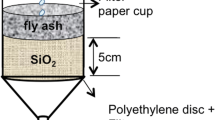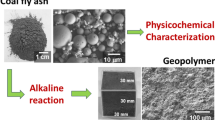Abstract
Coal fly ash (CFA) is a useful recycled resource for uses such as cement raw material. To manage and evaluate safety for effective utilization of CFA, the leaching concentration and amounts of toxic elements in CFA need to be determined. In this study, 38 types of CFA and aged CFA generated in Japan were used to measure the occurrence and leaching concentration range of As and Se. In addition, the leaching characteristics over the long term were examined using statistical analysis. Leaching concentrations of As and Se from CFAs were in the range of 0.001–0.163 mg/L (average: 0.025 mg/L, median: 0.014 mg/L) and 0.001–0.189 mg/L (average: 0.071 mg/L, median: 0.055 mg/L), respectively. In general, the concentrations of aged CFAs were less than those of the CFAs with a few exceptions. Leaching concentrations of As and Se in the tank leaching test changed with time, and As and Se concentrations in the dispersions increased with stirring time. In contrast, pH of the dispersion decreased with time. The relation between As or Se and CFA factors showed that As or Se and pH or Ca were highly correlated. However, in aged CFAs for long-term use, the correlation coefficient for the relation between As and other factors was low while that for Se-S was high. Considering the effective utilization of CFA as a long-term recyclable resource, the leaching processes of As and Se in CFA would change with time depending on the environmental conditions.








Similar content being viewed by others
References
American Coal Ash Association (ACAA). (2018). Production and Use Survey Results News Release, Nov. 2019.
Baba, A., Gurdal, G., & Sengunalp, F. (2010). Leaching characteristics of fly ash from fluidized bed combustion thermal power plant: case study: Çan (Çanakkale-Turkey). Fuel Processing Technology, 91, 1073–1080.
Bankowski, P., Zou, L., & Hodges, R. (2004). Reduction of metal leaching in brown coal fly ash using geopolymer. Journal of Hazardous Material, B114, 56–67.
Baur, I., & Johnson, C. A. (2003). Sorption of selenite and selenate to cement minerals. Environmental Science & Technology, 37, 3442–3447.
Bednar, A. J., Chappell, M. A., Seiter, J. M., Stanley, J. K., Averett, D. E., et al. (2010). Geochemical investigations of metals release from submerged coal fly ash using extended elutriate tests. Chemosphere, 81, 1393–1400.
Bhattacharyya, S., Donahoe, R. J., & Patel, D. (2009). Experimental study of chemical treatment of coal fly ash to reduce the mobility of priority trace elements. Fuel, 88, 1173–1184.
Bothe, V. J., & Brown, P. (1999). Arsenic immobilization by calcium arsenate formation. Environmental Science & Technology, 33(21), 3806–11.
Bothe, V. J., & Brown, P. (1998). Phase formation in the system CaO–Al2O3–B2O3–H2O at 23±1°C. Journal of Hazardous Material, 63(2), 199–210.
Catalano, J. G., Huhmann, B. L., Luo, Y., Mitnick, E. H., Slavney, A., et al. (2012). Metal release and speciation changes during wet aging of coal fly ashes. Environmental Science & Technology, 46, 11804–11812.
Central Electricity Authority (CEA). (2018). Report on fly ash generation at coal/lignite based thermal power stations and its utilization in the country for the year 2017-18. New Delhi, Dec. 2018.
Electric Power Research Institute (EPRI). (1987). Chemical characterization of fossil fuel combustion wastes. EA-5321.
Electric Power Research Institute (EPRI). (2006). Characterization of field leachates at coal combustion product management sites: arsenic, selenium, chromium, and mercury speciation. TR-1012578.
Electric Power Research Institute (EPRI). (2008). The leaching behavior of arsenic and selenium from coal fly ash. TR-1015545.
Grisafe, D. A., Angino, E. E., & Smith, S. M. (1988). Leaching characteristics of a high-calcium fly ash as a function of pH: a potential source of selenium toxicity. Applied Geochemistry, 3, 601–608.
Guo, Ba., Nakama, S., Tiana, Q., Pahlevia, N. D., Hub, Z., & Sasakia, K. (2019). Suppression processes of anionic pollutants released from fly ash by various Ca additives. Journal of Hazardous Materials, 371, 474–483.
Iwashita, A., Sakaguchi, Y., Nakajima, T., Takanashi, H., Ohki, A., et al. (2005). Leaching characteristics of boron and selenium for various coal fly ashes. Fuel, 84, 479–485.
Izquierdo, M., & Querol, X. (2012). Leaching behavior of elements from coal combustion fly ash: An overview. International Journal of Coal Geology, 94, 54–66.
Jankowski, J., Ward, C., French, D., & Groves, S. (2006). Mobility of trace elements from selected Australian fly ashes and its potential impact on aquatic ecosystems. Fuel, 85, 243–256.
Kashiwakura, S., Kubo, H., Kumagai, Y., Kubo, H., Matsubae, Y. K., et al. (2009). Removal of boron from coal fly ash by washing with HCl solution. Fuel, 88, 1245–1250.
Kashiwakura, S., Ohno, H., Matsubae, Y. K., Kumagai, Y., & Kubo, H. (2010). Removal of arsenic in coal fly ash by acid washing process using dilute H2SO4 solvent. Journal of Hazardous Material, 181, 419–425.
Komonweeraket, K., Cetin, B., Benson, C. H., Aydilek, A. H., & Edil, T. B. (2015a). Leaching characteristics of toxic constituents from coal fly ash mixed soils under the influence of pH. Waste Manage, 38, 174–184.
Komonweeraket, K., Cetin, B., Aydilek, A. H., Benson, C. H., & Edil, T. B. (2015b). Effects of pH on the leaching mechanisms of elements from fly ash mixed soils. Fuel, 140, 788–802.
Lange, C. N., Flues, M., Hiromoto, G., Boscov, M. E. G., & Camargo, I. M. C. (2019). Long-term leaching of As, Cd, Mo, Pb, and Zn from coal fly ash in column test. Environmental Monitoring and Assessment, 191, 602.
Lecuyer, I., Bicocchi, S., Ausset, P., & Lefevre, R. (1996). Physico-chemical characterization and leaching of desulphurization coal fly ash. Waste Management & Research, 14, 15–28.
Ma, S. H., Xu, M. D., & QiqigeX., & Zhou, X., Wang. (2017). Challenges and developments in the utilization of fly ash in China. International Journal of Environmental Science and Development, 8(11), 781–785.
Nakamura, K., Kuwatani, T., Komai, T., & Yamasaki, S. (2018). Extraction of surface soil geochemical characteristics of element concentration by principal component analysis. Journal of MMIJ, 134(2), 3–21.
Narukawa, T., Takatsu, A., Chiba, K., Riley, K. W., & French, D. H. (2005). Investigation on chemical species of arsenic, selenium and antimony in fly ash from coal fuel thermal power stations. Journal of Environmental Monitoring, 7, 1342–1348.
Natasha, S. M., Niazi, N. K., Khalid, S., Murtaza, B., Bibi, I., et al. (2018). A critical review of selenium biogeochemical behavior in soil-plant system with an inference to human health. Environmental Pollution, 234, 915–934.
Nugteren, H. W., Janssen-Jurkovícová, M., & Scarlett, B. (2001). Improvement of environmental quality of coal fly ash by applying forced leaching. Fuel, 80, 873–877.
Ogawa, Y., Sakakibara, K., Wang, L., Suto, K., & Inoue, C. (2014). Immobilization of B, F, Cr, and As in alkaline coal fly ash through an aging process with water. Environmental Monitoring and Assessment, 186, 6757–6770.
Ogawa, Y., Sakakibara, K., Seki, T., & Inoue, C. (2018). Immobilization of boron and arsenic in alkaline coal fly ash through an aging process with water and elucidation of the immobilization mechanism. Water, Air, and Soil Pollution, 229(11), 359.
Querol, X., Umaña, J. C., Alastuey, A., Ayora, C., Lopez-Soler, A., et al. (2001). Extraction of soluble major and trace elements from fly ash in open and closed leaching systems. Fuel, 80, 801–813.
Rafieizonooz, M., Mirza, J., Salim, M. R., Hussin, M. W., & Khankhaje, E. (2016). Investigation of coal bottom ash and fly ash in concrete as replacement for sand and cement. Construction and Building Materials, 116, 15–24.
Raposo, J. C., Zuloaga, O., Olazabal, M. A., & Madariaga, J. M. (2004). Study of the precipitation equilibria of arsenate anion with calcium and magnesium in sodium perchlorate at 25°C. Applied Geochemistry, 19, 855–862.
Saikia, N., Kato, S., & Kojima, T. (2006). Behavior of B, Cr, Se, As, Pb, Cd, and Mo present in waste leachates generated from combustion residues during the formation of ettringite. Environmental Toxicology and Chemistry, 25, 1710–1719.
Sandeep, P., Sahu, S. K., Kothai, P., & Pandit, G. G. (2016). Leaching behavior of selected trace and toxic metals in coal fly ash samples collected from two thermal power plants, India. B Environ Contam Tox, 97, 425–431.
Seki, T., Ogawa, Y., & Inoue, C. (2019). Classification of coal fly ash based on pH, CaO content, glassy components, and leachability of toxic elements. Environmental Monitoring and Assessment, 191, 358.
Siddique, R. (2004). Performance characteristics of high-volume class F fly ash concrete. Cement and Concrete Research, 34, 487–493.
Smith, A. H., Lingas, E. O., & Rahman, M. (2000). Contamination of drinking-water by arsenic in Bangladesh: a public health emergency. Bulletin of the World Health Organization, 78(9), 1093–1103.
Solem-Tishmack, K. J., McCarthy, G. J., Docktor, B., Eylands, K. E., Thompson, J. S., et al. (1995). High-calcium coal combustion by-products: engineering properties, ettringite formation, and potential application in solidification and stabilization of selenium and boron. Cement and Concrete Research, 25(3), 658–670.
Su, T., & Wang, J. (2011). Modeling batch leaching behavior of arsenic and selenium from bituminous coal fly ashes. Chemosphere, 85, 1368–1374.
van der Hoek, E. E., & Comans, R. N. J. (1996). Modeling Arsenic and Selenium Leaching from Acidic Fly Ash by Sorption on Iron (Hydr)oxide in the Fly Ash Matrix. Environmental Science & Technology, 30, 517–523.
Wang, J., Wang, T., Burken, J. G., Chusuei, C. C., Ban, H., et al. (2008). Adsorption of arsenic(V) onto fly ash: a speciation-based approach. Chemosphere, 72, 381–388.
Wang, T., Wang, J., Tang, Y., Shi, H., & Ladwig, K. (2009). Leaching characteristics of arsenic and selenium from coal fly ash: Role of calcium. Energy & Fuels, 23, 2959–2966.
Yao, Z. T., Ji, X. S., Sarker, P. K., Tang, J. H., Ge, L. Q., et al. (2015). A comprehensive review on the applications of coal fly ash. Earth Science Reviews. https://doi.org/10.1016/j.earscirev.2014.11.016
Zhang, Y., Cetin, B., Likos, W. J., & Edil, T. B. (2016). Impacts of pH on leaching potential of elements from MSW incineration fly ash. Fuel, 184, 815–825.
Acknowledgements
The authors thank JDC Corporation for supplying and analyzing the chemical compositions of coal fly ash samples. This work was supported through the Program for Leading Graduate Schools, “Inter-Graduate School Doctoral Degree Program on Global Safety,” by the Ministry of Education, Culture, Sports, Science and Technology.
Author information
Authors and Affiliations
Corresponding author
Additional information
Publisher’s Note
Springer Nature remains neutral with regard to jurisdictional claims in published maps and institutional affiliations.
Rights and permissions
About this article
Cite this article
Seki, T., Nakamura, K., Ogawa, Y. et al. Leaching of As and Se from coal fly ash: fundamental study for coal fly ash recycling. Environ Monit Assess 193, 225 (2021). https://doi.org/10.1007/s10661-021-08954-x
Received:
Accepted:
Published:
DOI: https://doi.org/10.1007/s10661-021-08954-x




